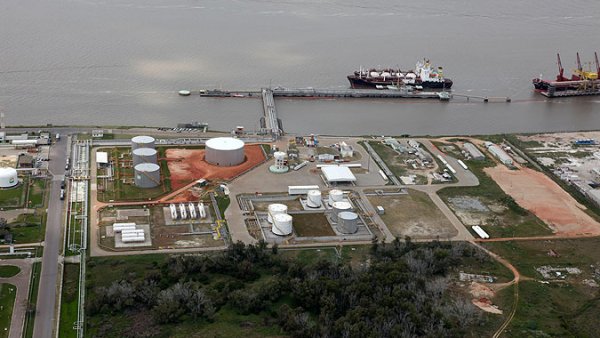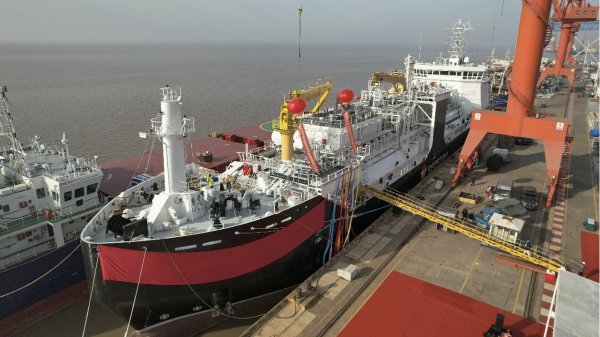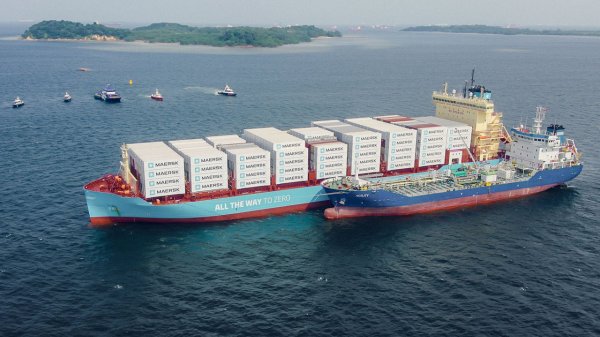Joint study to look into developing LNG-fuelled Capesize bulker
'Green Corridor' project partners to examine the feasibility of developing an LNG-powered bulk carrier.
An agreement has been reached to launch a joint study into developing liquefied natural gas (LNG)-fuelled Capesize bulk carriers. The project partners are: BHP Billiton, DNV GL, Mitsui O.S.K. Lines (MOL), Rio Tinto, Shanghai Merchant Ship Design and Research Institute (SDARI) and Woodside Energy.
All participating entities signed a letter of agreement at a ceremony in Singapore on 20th January.
The joint research project, called 'Green Corridor', aims to reduce sulphur and nitogen oxide emissions from merchant ships and is to examine the technological and economic feasibility of an LNG-powered bulker.
"MOL Group continually takes a proactive approach to developing and adopting technologies that contribute to reducing environmental impact and enhancing safe operation, while providing safe and reliable transport services", project participant MOL said in a statement.
As previously reported by Bunker Index, construction of what is set to be the world's largest LNG-powered bulk carrier is in progress at the Hyundai Mipo Dockyard in South Korea. It is due to be launched in late 2017 and scheduled to start transporting limestone from Gangwon-do to Gwangyang as early as 2018.
The new bulker will be able to carry up to 50,000 tons of cargo. Currently, the largest bulk carrier powered by LNG fuel is able to store around 7,000 tons of cargo.
Meanwhile, ESL Shipping's two large LNG-fuelled bulk carriers are being built at Sinotrans & CSC Shipbuilding's yard in Nanjing, China. Due for delivery in early 2018, the two 25,600-deadweight-tonne (dwt) ships have type C LNG tanks with a capacity of approximately 400 cubic metres, enabling bunkering at several terminals within the Baltic region.
All participating entities signed a letter of agreement at a ceremony in Singapore on 20th January.
The joint research project, called 'Green Corridor', aims to reduce sulphur and nitogen oxide emissions from merchant ships and is to examine the technological and economic feasibility of an LNG-powered bulker.
"MOL Group continually takes a proactive approach to developing and adopting technologies that contribute to reducing environmental impact and enhancing safe operation, while providing safe and reliable transport services", project participant MOL said in a statement.
As previously reported by Bunker Index, construction of what is set to be the world's largest LNG-powered bulk carrier is in progress at the Hyundai Mipo Dockyard in South Korea. It is due to be launched in late 2017 and scheduled to start transporting limestone from Gangwon-do to Gwangyang as early as 2018.
The new bulker will be able to carry up to 50,000 tons of cargo. Currently, the largest bulk carrier powered by LNG fuel is able to store around 7,000 tons of cargo.
Meanwhile, ESL Shipping's two large LNG-fuelled bulk carriers are being built at Sinotrans & CSC Shipbuilding's yard in Nanjing, China. Due for delivery in early 2018, the two 25,600-deadweight-tonne (dwt) ships have type C LNG tanks with a capacity of approximately 400 cubic metres, enabling bunkering at several terminals within the Baltic region.

|
VARO Energy expands renewable portfolio with Preem acquisition
All-cash transaction expected to complete in the latter half of 2025. |
|
|
|
||

|
NYK trials biofuel in milestone coal carrier test
Vessel is used to test biofuel for domestic utility company. |
|
|
|
||

|
H-Line Shipping orders LNG bunkering vessel
Vessel with 18,000-cbm capacity to run on both LNG and MDO. |
|
|
|
||

|
How to engineer and manage green shipping fuels | Stanley George, VPS
Effective management strategies and insights for evolving fuel use. |
|
|
|
||

|
Swedish government bans scrubber wastewater discharges
Discharges from open-loop scrubbers to be prohibited in Swedish waters from July 2025. |
|
|
|
||

|
MAN Energy Solutions achieves 100% load milestone for ammonia engine
Latest tests validate fuel injection system throughout the entire load curve. |
|
|
|
||

|
Petrobras secures ISCC EU RED certification for B24 biofuel blend at Rio Grande
Blend consisting of 24% FAME is said to have been rigorously tested to meet international standards. |
|
|
|
||

|
Stolt-Nielsen to fully control Avenir LNG with acquisition
Share purchase agreement to buy all shares from Golar LNG and Aequitas. |
|
|
|
||

|
Bureau Veritas supports launch of CIMC SOE's LNG bunkering vessel
Handover of Seaspan Energy's cutting-edge 7,600-cbm vessel completed. |
|
|
|
||

|
Methanol as a marine fuel | Steve Bee, VPS
How environmental legislation has driven the development of low-sulphur fuels and methanol-ready ships. |
|
|
|
||
Related Links
- · Construction agreement for large LNG-fuelled bulkers [Insights]
- · LNG-fuelled bulker project puts spotlight on high manganese steel [Insights]
- · High manganese steel tanks for world's largest LNG-fuelled bulker [Insights]
- · LNG-fuelled bulkers set for 2018 Baltic launch [Insights]
- · New rule set class contract for LNG-fuelled bulkers [Insights]
- · Japan [Directory]

